A Daring Rescue Highlights Giraffes’ Silent Extinction
17:33 minutes
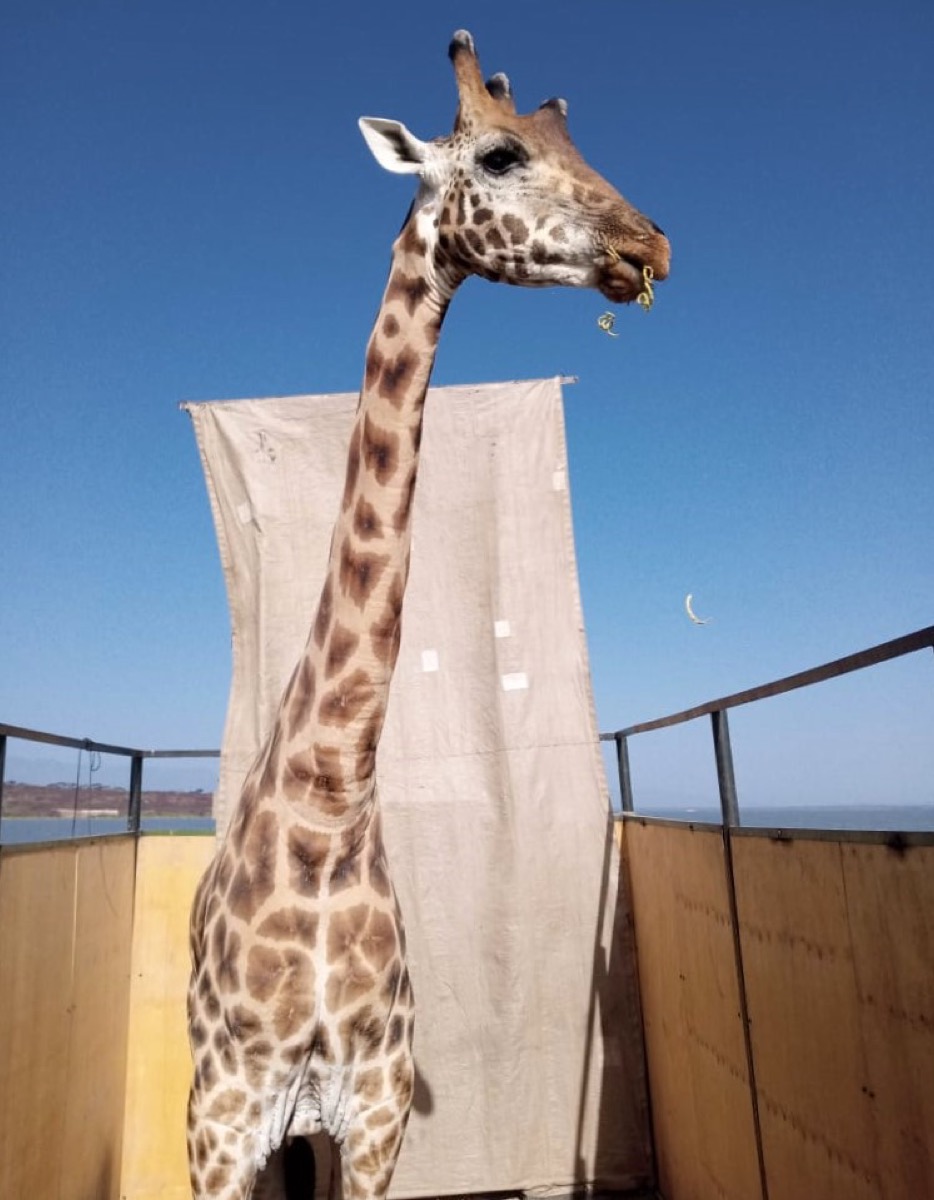
For the past several months, a daring and unprecedented rescue mission has been underway in western Kenya. Local conservationists have been slowly puzzling out how to ferry nine stranded giraffes trapped on a flooded peninsula back to the mainland. The team rescued the most vulnerable first by sedating them for the duration of the journey. But for others they tried a less dramatic approach—coaxing the giraffe with food onto a wooden barge. “We called it the girRAFT,” said David O’Connor, president of the non-profit group Save Giraffes Now. “Some were better sailors than others.”
This week, the final four Rothschild giraffes will be moved to safety. It was a valiant, months-long effort, for the sake of nine giraffes. But this small tower—the technical word for a group of giraffes—represents one percent of the total population of its species. There are only about 800 northern giraffes left in Africa.
O’Connor calls this charismatic animal’s decline a “silent extinction.” He joins Science Friday to talk about why giraffe populations are plummeting, and why we should be paying attention. View more photos and video of the rescue effort below.
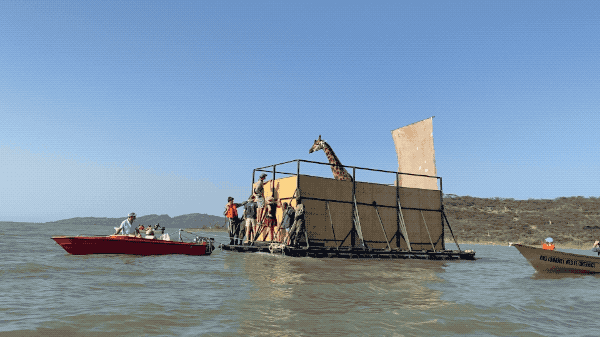
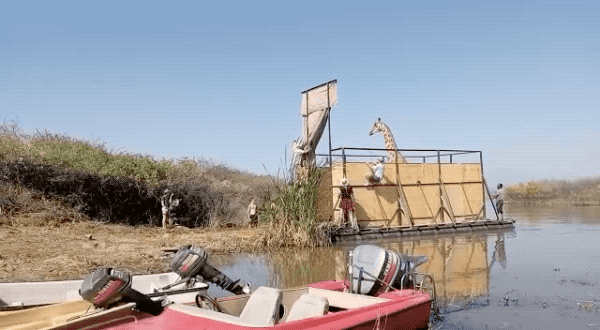
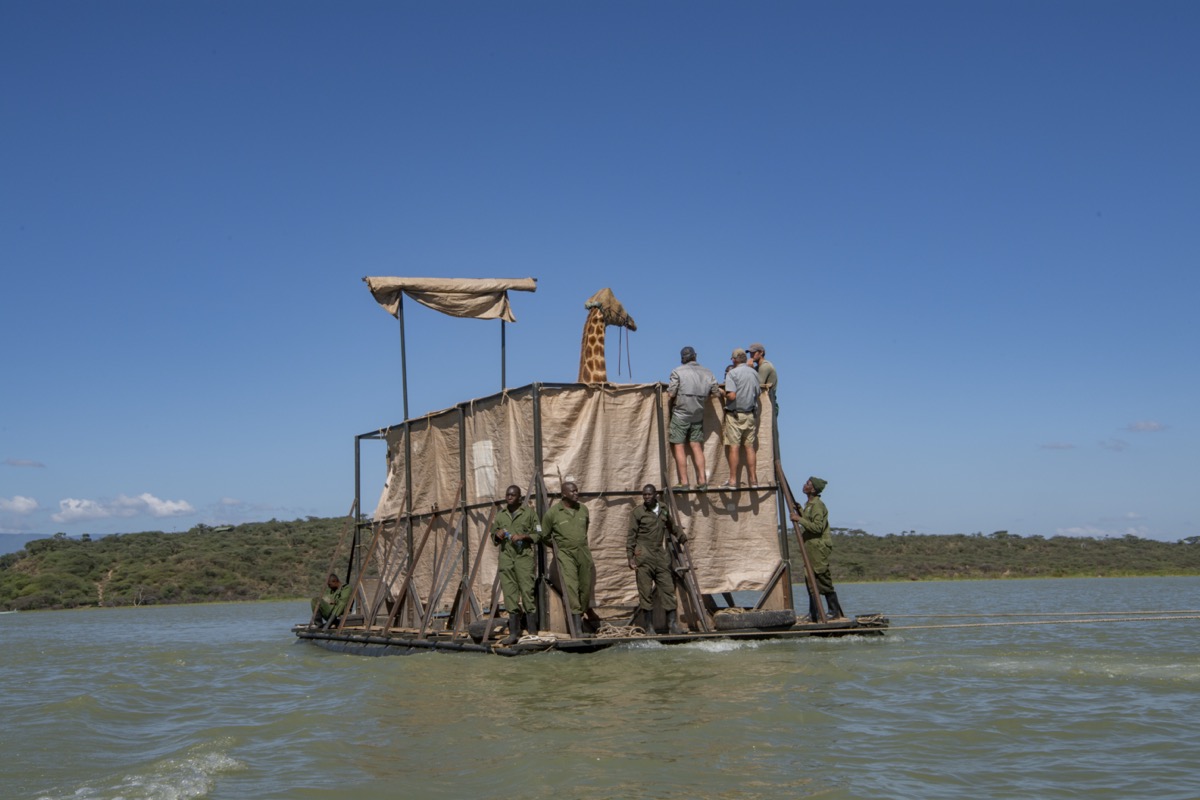
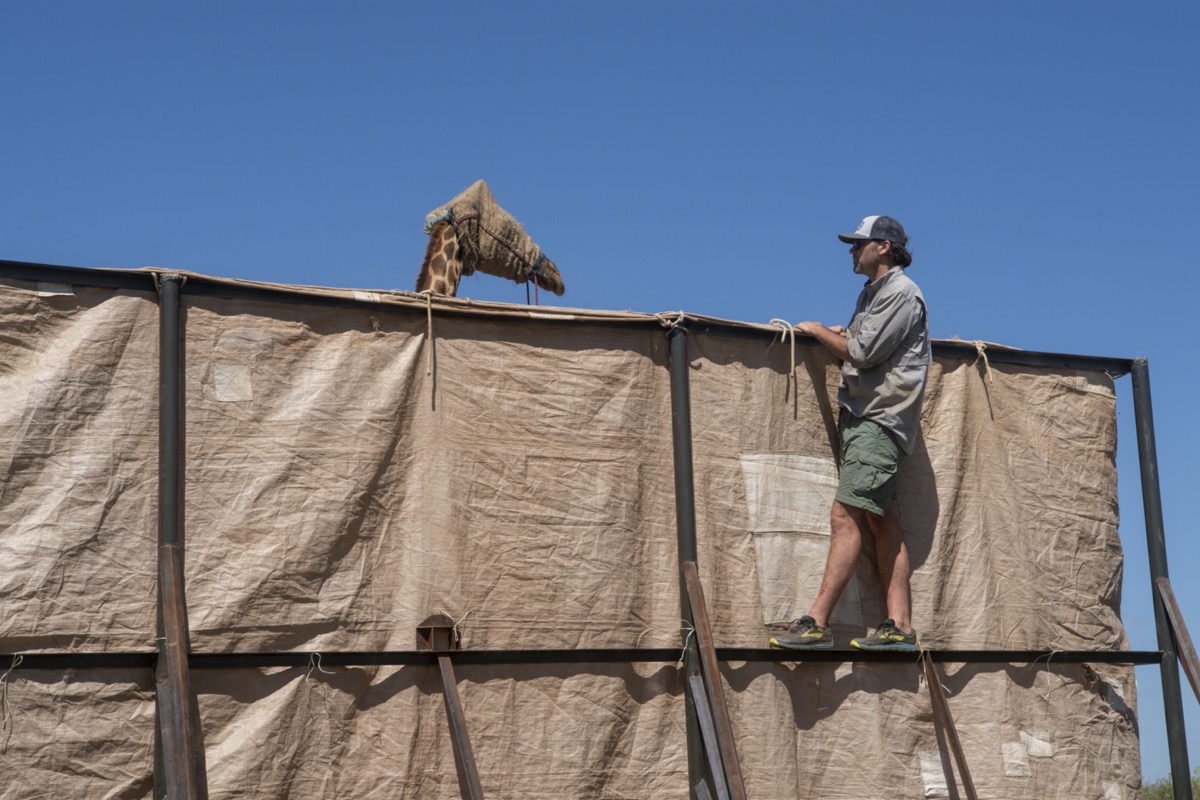
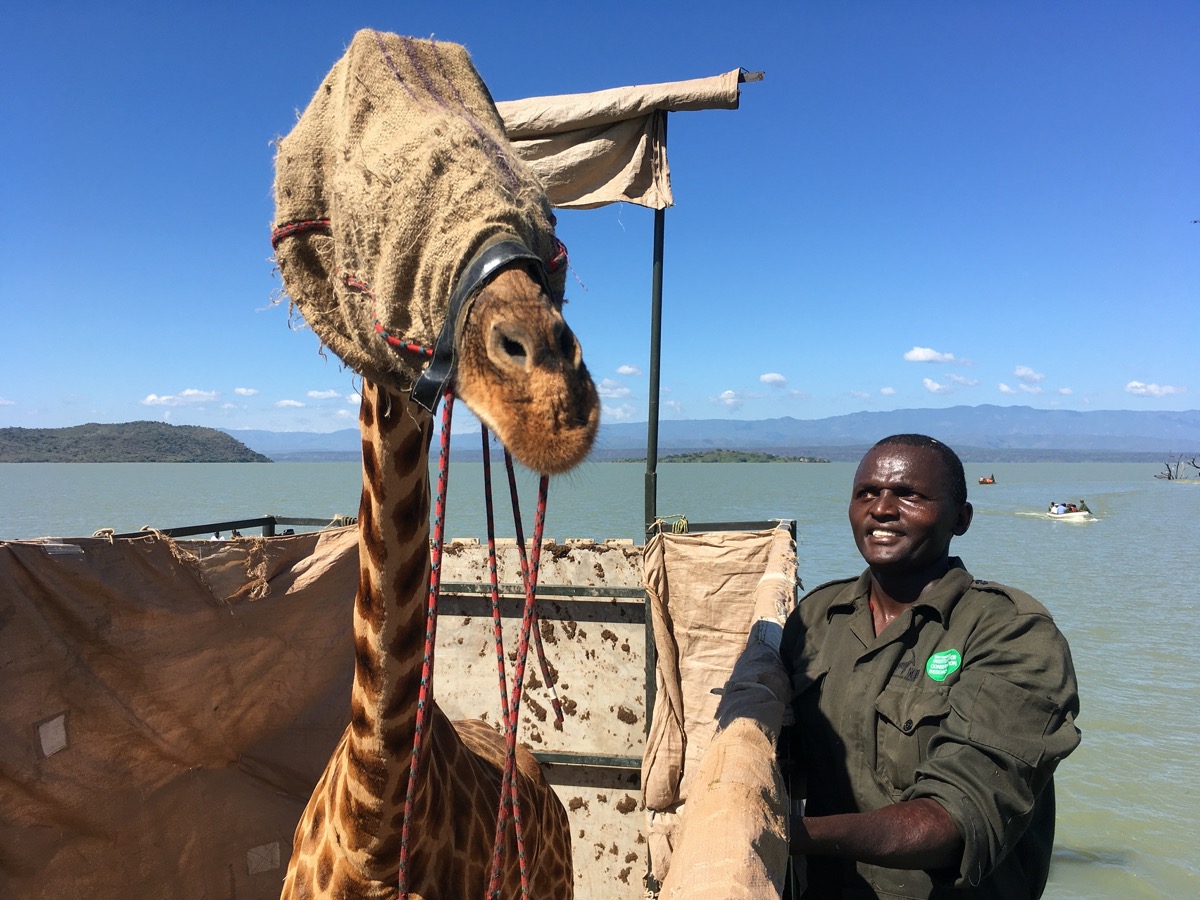
Asiwa, photoed above, was moved on the barge for 1.1. miles to the 4,400-acre fences sanctuary within the 44,000 acre Ruko Conservancy. Asiwa was isolated on a far part of the island.
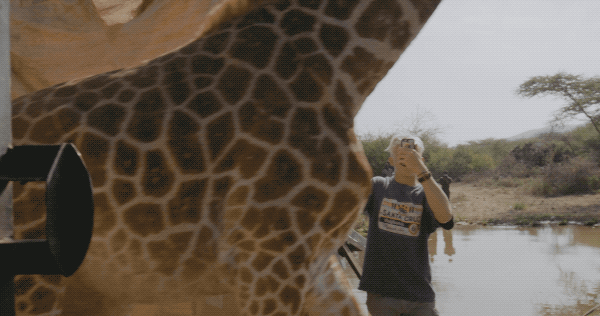

Invest in quality science journalism by making a donation to Science Friday.
David O’Connor is president of Save Giraffes Now and research associate at Smithsonian Institute in Washington, D.C.
IRA FLATOW: This is Science Friday. I’m Ira Flatow. Ever heard a giraffe roundup?
[CHATTER]
For the past several months, a daring and unprecedented rescue mission has been underway in western Kenya. Local conservationists have been slowly puzzling how to ferry nine stranded giraffes trapped on a flooded peninsula back to the mainland. They rescued the most vulnerable first, forced to sedate them for a duration of the journey. But for others, they tried a less dramatic approach, coaxing the giraffe with food onto a wooden log barge. And this week the last four giraffes will be moved to safety.
[CHATTER]
A valiant month’s long effort all four nine giraffe, but this small pod represents 1% of the total population of its species. Only 800 northern giraffe remain in Africa. My next guest calls this the silent extinction. Giraffe populations are plummeting all while we haven’t been paying attention. Dr. David O’Connor, conservation researcher and president of the nonprofit organization Save Giraffes Now. Dr. O’Connor, welcome to Science Friday.
DAVID O’CONNOR: Thank you so much, Ira, and thanks so much for having us and for focusing on giraffe.
IRA FLATOW: Give me an idea of what this looks like, the peninsula where the giraffe were stranded.
DAVID O’CONNOR: Yeah. So it’s– yeah, it was a peninsula going into Lake Baringo in western Kenya. It was about 100 acres in size, this peninsula. And nearly 10 years ago, eight giraffe were brought to this peninsula to reintroduce them into the region after 70 years of being extinct there. And they were reintroduced to the peninsula because the community and the wildlife authorities thought that that’s the best place we can reintroduce them. They’ll be safe there, we can defend them from poachers there, and then as conditions improve, they can easily access the mainland.
Well, unfortunately, the lake had other ideas and decided to rise about 40 to 50 feet, completely flooding the peninsula and creating this island that we’re left with today.
IRA FLATOW: Wow, I didn’t realize how few giraffes there were left.
DAVID O’CONNOR: Yeah, unfortunately, when you put all the giraffe together in Africa, there’s only about 100,000 left. That’s our best estimate. And that sounds like a lot, but if you compare it to, say, elephants, there’s about 400,000 to 500,000 elephants left. So there really are very, very few giraffe left, and of the four species, three are considered endangered or critically endangered. So we really do have to act now to try to save these giraffe across the continent.
IRA FLATOW: You say that the giraffe are experiencing a silent extinction. What exactly do you mean by that?
DAVID O’CONNOR: It’s really as you said in your introduction that, unfortunately, they’re slipping away but they’re not getting the attention. It’s not really raising the alarm bells the way perhaps it should be and in the public consciousness. I think people are familiar with what’s happening with rhino generally or elephant or even lions or panda, but giraffe are so famous– and you see them in kids books or on television or in cartoons– but nobody really knows what’s happening with them in the wild.
IRA FLATOW: Are there certain species of giraffe that are more in danger than others?
DAVID O’CONNOR: Yeah. The northern giraffe species that you mentioned are the most imperiled, and then the reticulated and the Maasai giraffe are also endangered. Thankfully the giraffe across southern Africa, the southern giraffe, they’re actually doing OK as a species, and their populations are stable. So conservation-wise we’re really focused on those three other species.
IRA FLATOW: You talk about the articulated giraffe and the other species. I don’t think most of us realize that giraffe can look different from one another.
DAVID O’CONNOR: Yeah. Yeah. They can, and generally speaking they look giraffe-ish with the long neck and the long legs. But, yeah, when you put them side by side, they’re really quite different, and genetically speaking the difference between them as a species are the same as a brown bear is from a polar bear, say.
IRA FLATOW: Wow. Does that mean that they diverged from some common ancestry relatively recently?
DAVID O’CONNOR: It’s actually further back than we think because they are quite distant, but some of them do still maintain the ability hybridize and produce a hybrid calf. So they’re not all that far back, but they did come from a common ancestor. And I think it was mostly geographical separation that sent them on their different species lines.
IRA FLATOW: You said that we know very little about giraffe. Maybe it’s easier to ask what we don’t know about them.
DAVID O’CONNOR: Yeah. That’s a really good question, and it’s one of the reasons I got interested in giraffe because we know so very little about them. We don’t with great certainty their numbers. We have estimates like I’ve said, but we don’t know a great certainty. We don’t really know where they are. We don’t know how many are left in Ethiopia or where they are in South Sudan or in Somalia, for instance.
We don’t know their home range sizes. We don’t know their seasonal migration routes. We don’t know their social structures in terms of how they herd together or even how they communicate. Do they communicate? They’re largely silent. And I would argue we still don’t know the reason why they have a long.
IRA FLATOW: Yeah, that is really interesting. I’ve always wondered about that long neck. There’s that whole Lamarck thing about giraffe have long neck.
DAVID O’CONNOR: Yeah.
IRA FLATOW: I also find it really interesting that they have only seven vertebrae in their neck like we do, but they’re much bigger vertebrae, right?
DAVID O’CONNOR: Yeah. Yeah, isn’t that bananas? I love that fact. They just have really, really big vertebrae. They also have a really unique blood flow system, which I find fascinating. They’re like to me like a carefully engineered race car or a Formula One car. They’re very precision engineered beings.
Because sometimes– when you stand up too quickly, sometimes we feel a bit woozy. Well if you can imagine if you’re drinking as a giraffe at the level of your feet and something startles you and you whip your head up through an arc of 19 feet, why don’t they pass out every time they stand up straight?
IRA FLATOW: Right, right, yeah.
DAVID O’CONNOR: So they have this unique blood flow system with sets of valves to stop the blood back flowing quickly or going all the way to their head and having a hemorrhage. it’s– they have like compression socks basically built into their legs. They’re absolutely fascinating. They’re really– and they’re the watchtowers of the savannah. Other species depend on them and will herd around them at the bottom of their feet because they’ll be the first ones to see danger.
IRA FLATOW: Wow. Can they use their necks aggressively or to fight with or fend off people– people– other animals that want to attack them?
DAVID O’CONNOR: Yeah. Yeah, well, Ira, you laugh about fending off people, but I have been kicked by a giraffe and broke my ribs so–
IRA FLATOW: Oh, is that right?
DAVID O’CONNOR: Yeah, they do fend off people, too. Mostly they use their legs for defense against other species. Their kick can kill a lion, for instance. But for their necks– and that’s one of the thoughts about how they got the long neck– is they use it in fights either to gain a sort of hierarchy of dominance or also for access to females. And it’s usually the males that fight.
And what they do is they swing their heads like a mallet and bash each other on their sides with their heads, and they use their necks to swing through that motion. And the sound of the impact, it’s like this big thoom, and you can feel it in your chest. So they really are hammering each other with their heads. It’s quite a spectacle.
IRA FLATOW: We’ve been having fun in talking about how the giraffe used parts of their bodies, but the serious question about their extinction, I’m wondering whether we don’t notice much, why it’s such a silent extinction, because we don’t think of poachers selling ivory and killing him for that reason.
DAVID O’CONNOR: Yeah. Yeah. You’re exactly right. And it’s– they– it’s also a function of not many people are working on them or just watching them. So you also don’t have many people– you don’t have many eyes on them to raise that alarm. But for giraffe, when it comes to poaching, they’re not poached for those trophy items like rhino horn or ivory that we’ve heard about, but they’re poached more for bushmeat and it’s mostly in country. And it’s unfortunately when it gets to the scale of being commercialized where you have people going out on motorbikes in gangs with automatic weapons and the meat’s being taken to commercial centers and being sold that way, that’s when it’s not sustainable and the population just gets hammered.
IRA FLATOW: Tell me more about your non-profit Save Giraffes Now. How many projects, how many savings, rescues have you had to do?
DAVID O’CONNOR: Yeah, so right now Save Giraffes Now is working across nine countries in Africa with partners, and we focus on three main priority areas that we think impact and help giraffe now. It’s in our name. We really our action orientated, so we’re very much focused on rescues and rewilding as you say.
We also focus on anti-poaching, which is hugely important. And then we focus on community led projects where we’re working with local communities to monitor giraffe and then also we’re setting up giraffe rescue centers for giraffe calves that have become orphaned. Either their parents or mother has been poached or killed or they’ve become very far separated from the herd and can’t find their way back. And so with this current reintroduction project off the island, it’s– right now we’re moving nine giraffe off the island, and we’ll also reintroduce another say 12 back into this area to start this breeding population in the Ruko Conservancy where they disappeared 70 years ago
But with the orphan program, we’re able to save and release back to the wild you know tens of giraffe. And we’re growing that as more country as a resources allow.
IRA FLATOW: So that program where you’re rescuing the giraffes now because the lake was flooding, that has been successful?
DAVID O’CONNOR: Yeah, thankfully it has. There were nine giraffe trapped on this island, and as of today, we have rescued five successfully. And there are four more left on the island that are actually being rescued this week. I was meant to be there, but with COVID restrictions in Kenya at the moment, I wasn’t able to go. But the team on the ground there are excellent, so we’re all watching our phones for updates from Kenya to see how that’s going.
IRA FLATOW: So what’s the plan? Do you rescue them and you wait for the waters to recede and then put more giraffe back there?
DAVID O’CONNOR: Well, that was our big problem is how do you get the world’s tallest animal off an island when it doesn’t swim. The lake levels at the time when we started this were rising about six inches a day. And there was one giraffe particularly that was trapped alone on this sliver of island that was really going to be flooded, so we had to move quite quickly. And so together with the community and the wildlife authorities and our partners, we created this raft, and we’re actually sailing the giraffe off the island if you can believe.
IRA FLATOW: I’m– yeah, I’m trying to think this giraffe I’m thinking is top heavy on a raft, right?
DAVID O’CONNOR: Yeah.
IRA FLATOW: Well–
DAVID O’CONNOR: Yeah.
IRA FLATOW: Well, what worse combination could you have?
DAVID O’CONNOR: Exactly, yeah. Yeah. But the community, they built this raft, which we’ve nicknamed the Giraft. That– and it’s a real engineering marvel actually. They put together 60 steel basically oil drums together and then put the planks and stuff on top of it and created this very, very stable square base, and then we built up the sides about 10 feet so the giraffe don’t go into the water.
And it’s been amazing. We’ve been taken in the giraffe one by one off. Some I’ll admit are better sailors than others, but it’s been so far very, very successful in that no giraffe have got injured, no people have got injured, and they’ve all joined up on the mainland together forming a new herd.
IRA FLATOW: So you had to McGuyver the whole thing to create the raft.
DAVID O’CONNOR: Right. Yeah. Yeah, you’re right, if you can imagine Ruko is very remote. And you have to sail everything in by boat most of the times because the roads are impassable possible in the rainy season, et cetera. And the team they’re just incredible, so resourceful and talented to be able to create this engineering marvel that’s now saving these giraffe.
IRA FLATOW: This is Science Friday from WNYC Studios talking with Dr. David O’Connor, president of Save Giraffes Now and a researcher associated with the Smithsonian Institution. This is– I’ve never heard of a giraffe rescue or the need to rescue giraffes. You were talking a bit before, people eat the giraffes. Is that the problem?
DAVID O’CONNOR: Yeah, in certain places. So there’s four main reasons for the decline of giraffe across Africa. At the top of the list is loss of habitat and habitat degradation and fragmentation. That affects so many species.
Then there is prolonged droughts and the less dependable rains that are now we’re seeing because of climate chaos and climate change. And then in certain countries in Africa, it’s poaching is very, very heavy and taking a very heavy toll on these giraffe, and it is for meat. And it’s– maybe if it was at a village or a family level where they really are desperate for protein, that might be sustainable, but when it’s commercialized where in these areas and where you have people coming in on motorbikes or with automatic weapons are just plowing down the giraffe and bringing the meat into town into commercial centers, that’s when you really, really see the populations going way down.
IRA FLATOW: And is it giraffe called a pod instead of a herd? Is that what–
DAVID O’CONNOR: It’s actually, believe it or not, called a tower.
IRA FLATOW: That sounds right, a tower.
DAVID O’CONNOR: Yeah. Whoever came up with that deserves some kind of award I think.
IRA FLATOW: And what is a typical tower composed of, one male, many females? How does that work?
DAVID O’CONNOR: Well, as we were saying at the beginning, we don’t know. We still don’t know because if you look at a giraffe tower and say start with five giraffe in this tower, it’s not like a herd of sheep, say, where there’s 10 sheep and they go round they all stay together and that’s it. That’s the herd.
In the tower, you’ll start with five giraffe. Suddenly two might wander in out of nowhere, and they join up for a while. Then one might move off somewhere else and go wander off into the distance. So they’re not stable. They’re a fission fusion type dynamic we call it.
But mostly I would say they’re female dominated, these towers, and they come together and have semi stable relationships and then also for their calves. And then basically the mature males go from female tower to female tower to female tower basically trying to get lucky I think.
IRA FLATOW: And when you bring in the giraffe, the tower, to the breeding area that what used to be the peninsula now is the island, which will become a peninsula again, how do you know how many of what kind to bring in there?
DAVID O’CONNOR: Right. So we knew historically that this area of Kenya had a type of northern giraffe called the Rothschilds giraffe, also known as the Nubian giraffe. So we knew that they were involved for that area, and it was very much 70 years ago the center of their range in Africa. And unfortunately they were wiped out by poaching and being caught in human conflict over 70 years ago.
And so we knew that it was Rothschilds that had to go back in, and with the Ruko Community Conservancy there, that’s 44,000 acres. They were very keen to bring back giraffe to their land. And so we thought this was the perfect opportunity to get giraffe back in onto the mainland off the island and then also bring in some more to start a breeding population. And just saving these giraffe from the island are a first step.
IRA FLATOW: This has been fascinating, Dr. O’Connor, for– wow, for all of us. I learned so much about giraffes and about your rescue efforts. Thank you very much for taking time to be with us today.
DAVID O’CONNOR: Thank you so much. It’s been a pleasure.
IRA FLATOW: Dr. David O’Connor, conservation researcher, president of the non-profit Save Giraffes Now. We’re going to take a short break, and when we come back, we’re going to talk about Alzheimer’s disease and a new study that links it to lifestyle and nutrition. Stay with us. We’ll be right back after this break.
Copyright © 2021 Science Friday Initiative. All rights reserved. Science Friday transcripts are produced on a tight deadline by 3Play Media. Fidelity to the original aired/published audio or video file might vary, and text might be updated or amended in the future. For the authoritative record of Science Friday’s programming, please visit the original aired/published recording. For terms of use and more information, visit our policies pages at http://www.sciencefriday.com/about/policies/
Katie Feather is a former SciFri producer and the proud mother of two cats, Charleigh and Sadie.
Ira Flatow is the founder and host of Science Friday. His green thumb has revived many an office plant at death’s door.